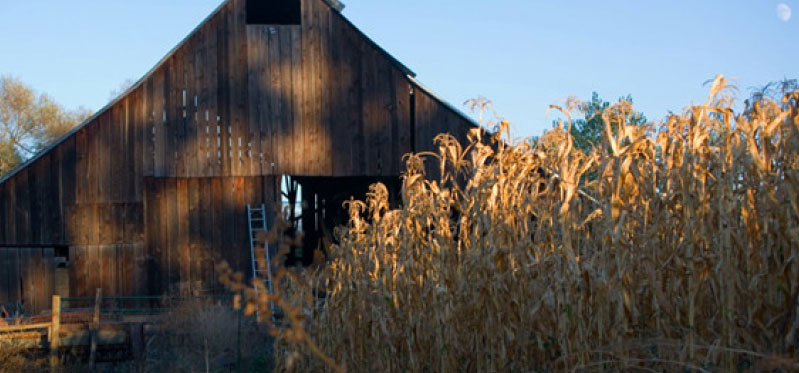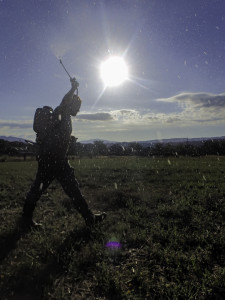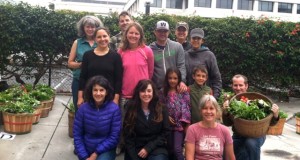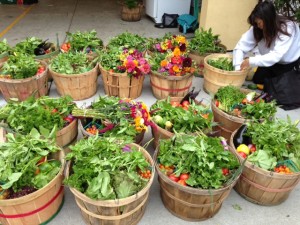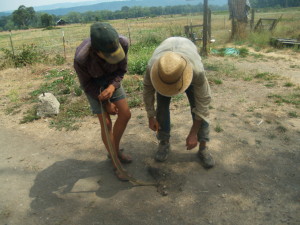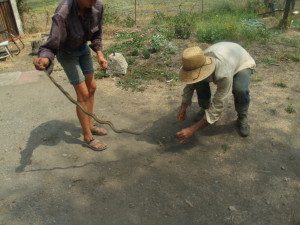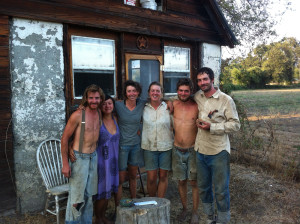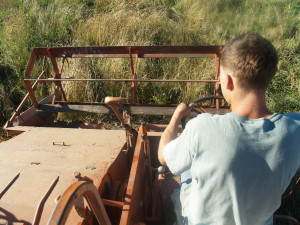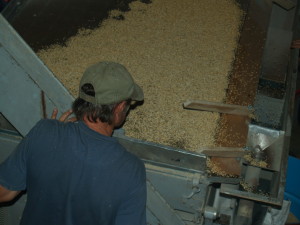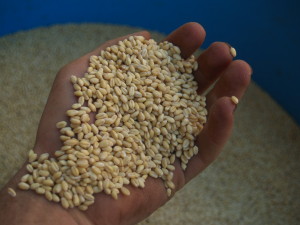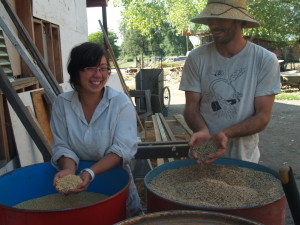The following article appeared in the Biodynamics journal from Fall of 2012, written by Karen Davis-Brown.
It’s always fun to hear from Rebecca, the editor of Biodynamics, with her latest assignment. However, I was not prepared for the power and inner growth that came with her request to interview some of the presenters for November’s conference in Madison.
My counter proposal was deceptively simple — to interview a group of presenters of my own choice with an initial set of written questions regarding their perception of “the sacred,” based on their decades of work and lives in biodynamics. Based on their responses, we then shared a one-on-one phone follow-up conversation.
The presenters I interviewed were: veterinarian Dana Burns and educator Janet Gamble from East Troy, Wisconsin; permaculture teacher and advocate Mark Shepard from the Viroqua Wisconsin area; Stephen Decater from Live Power Farm in Covelo, California; and consultant Laura Riccardi Lyvers from Kentucky. In spite of their diverse ages, locations, practices, and experiences, several strong, common themes ran through their responses and form this article.
What first impressed me about the presenters I chose to interview was that, at this busy time of year, they took the time to answer my questions and to share their stories and perceptions with me. I am grateful and humbled by the breadth and depth of their commitment to the larger biodynamic community and to the future of humanity in general. And, throughout the interview process I was awed and humbled by their struggles and successes in putting images and experiences that are beyond words into words for the rest of us.
My heartfelt apologies to the presenters whom I was not able to interview. I am sure you understand the limitations of space, time, and the seasonal demands of September. Every one of us has stories to tell, and I trust that this article will stimulate the sharing of such experiences and observations when we are together at the conference.
“This is How the Cosmos Thinks”
One of the strongest themes knitting together these interviews was the unequivocal assertion that work in agriculture is fundamentally a partnership and relationship with the spiritual world, from each elemental who forms a plant or stone to those who guide the planets and stars. In biodynamics we understand the crucial role that the human ego plays as the bridge of consciousness and “hands,” or activity, that either contributes to or detracts from the progress of all creation. For instance, when I asked Mark Shepard how experiences in his life contributed to his current understanding of agriculture and the sacred, he referred back to his years in the Alaska wilderness. That is where he learned that life and work are a seamless experience of the sacred and that is “how the cosmos thinks.” He then brought that experience and understanding into his work in agriculture.
In our phone conversation, Mark elaborated on Rudolf Steiner’s fundamental assertion that the way human beings think is often far from how the cosmos thinks. Our use of language and concepts influences the way we experience the world. We can program ourselves to think that the sacred is not here and now, or that the sacred is here and now. Mark noted that his work in permaculture and biodynamics complement each other because both emphasize percept/observation over precept/concept. In the handbook for Permaculture, Bill Mollison stresses over and over again “observe, observe, observe,” and permaculture’s principles of design reflect the principles of biodynamics and Steiner’s threefold social order: earth care, people care, and economic equity. Biodynamic agriculture’s stress on the importance of diversity in species and land use is also a fundamental understanding it shares with permaculture.
Laura Riccardi Lyvers affirmed Mark’s approach:
…it is part of my job to observe deeply, to notice how influences express themselves through the landscape, the livestock, the pastures or gardens.
Stephen Decater offered a vivid description of one experience where a farmer’s observation led to a new understanding of the sacred:
…I was walking between fields thinking about the land, the plants, and all that goes on and is living there, and suddenly I was overwhelmed by the realization that all of this was being constantly created as a loving gift out of the spiritual…. I felt, yes, as a farmer I did work, but it was miniscule in light of the huge support that was pouring out as an unconditional gift of creation.
Dana Burns encouraged the early and ongoing exposure of children to nature and agriculture, where adults model and teach respect for other beings. “Not in petting zoos,” she asserted, but in ways where children provide service to their fellow creatures, and thereby develop their observational skills and will forces. Many biodynamic operations provide this opportunity for experience and meaningful work to school children as part of their mission.
The Healing Power of Beauty
Another recurring theme was the overwhelming experience of the beauty and healing that is offered by the natural world if we are open and present in our agricultural work. One example was an experience shared by Stephen Decater from his early days in the Alan Chadwick Gardens at UC Santa Cruz. He wrote:
… I was just turning 21 and working as an apprentice gardener with Alan Chadwick….It was that time of day when the afternoon was flowing into evening and the light was golden; eggplant time in the spring. The air was finally carrying a gentle warmth and the soil was soft and alive. Alan had explained how we were going to water in the plants with warm water because “Aubergine” was a creature of warmth. Of an instant I was engulfed in that other world of warmth and life and love despite the fact that it was 1968 and people were slaughtering each other in Vietnam and creating misery through out the world. That was when I knew there was also beauty in the world and it had the power to heal.
Later in life, as an established and respected biodynamic practitioner, he experienced a much different aspect of healing:
Then in my 40’s when my self ego had me really convinced that I knew … it all, I was pruning fruit trees… and all at once saw all the miscuts that I had inflicted on that tree over the years and the tree’s efforts to recover and heal itself. My arrogance was destroyed….I was empty and unacceptable and utterly and completely isolated and alone. I became unable to work or participate in life and stopped eating. After days and months of struggle, finally, out of desperation, I got out of bed and wandered out to the barn. There were horse plops there. I mechanically took the shovel and began to pick them up. In that instant, I was surrounded by thousands of people reaching back through all ages of time and they were people who understood and cared, people who had shoveled manure and returned it to the earth for millennia. It did not matter that I was broken, I was no longer alone.
There are these moments of extreme revelation and emotion in our daily work on the farm, but there are also the longer term applications of knowledge, love, and willpower to heal a landscape and farm organism. Mark Shepard shared one such experience on his farm:
Our farm is a ridgetop farm surrounded by thousands of acres of corn and beans. There is no surface water (pond, stream, etc) within a mile and a half…. On this farm, however, there are several sites where one can see that there once was a spring that has long since dried up because of 150 years of abusive land use. By building terraces, swales, berms and dozens of vernal pool … we not only soak more water into the ground, but we create habitat for amphibians. It took several years before the first ones showed up, but what a joy it was to hear our first spring peepers on the farm….To hear frogs singing in the rain is sacred. To know that it is a result of me farming here that amphibians now have places to live, is sacred.
Janet Gamble, who for many years trained future practitioners, finds the “healing power of beauty” in her educational work:
….for me the real work has been cultivating souls as much as teaching farming….Working with interns at Michael Fields over the years, we co-created food and beauty – both vital to the development of healthy human beings….A garden is the inner reflection of oneself and a place to work through one’s inner development. The results were both practical and ephemeral.
“Divine Doing”
At this time in human evolution, it is very easy to believe that thinking and reading and enjoying and having emotions is the same as doing. However, another strong theme throughout these interviews was the importance of engaging will forces in an active and positive way. That is how we take our place as human beings between the elemental and angelic realms. Only we can make decisions and carry them out, in the partnerships that create a farm organism.
Laura Riccardi Lyvers offered a litany of what she calls “divine doing:”
When I stir preps for the farm, it is often…a sacred moment….Gratitude, reverence….opening up to the phenomenon that is life…..and receiving bits and pieces of awareness….And of course, in the making of the biodynamic preparations, ….The preparations themselves are bringers of awareness towards our spiritual potential in our relationship with earth. Even…the roar of the tractor and mechanical power that it takes to stir 200 gallons of water for each batch of preps, there is recognition of divine doing….I witness the devotion of my husband to his “conventional” hog & grain farm: hundreds of acres in cover crops of crimson clover, vetch and buckwheat…humming with life, glowing with radiant beauty. Manure and preps made from his livestock and our herbs, to feed the life of the soil & field…which will in-turn feed his livestock a more spiritualized nutrition.
Mark Shepard described how observation can lead to divine doing:
I was in our woodshed one day and I watched as an orchard mason bee flew in carrying a cabbage-looper caterpillar. It crawled around on one of the 2X6 studs and found an ant-hole. It proceeded to stuff the caterpillar into the hole. I waited for several minutes and watched it do this three more times. I then took out a set of drills and measured the diameter of the favored hole as well as the depth. I then proceeded to drill zillions of similar holes in the studs of the woodshed. It is a thrill to see most of the holes now serving as nesting sites for orchard mason bees, carpenter bees and other wild pollinators. By observing and then assisting in a natural process we now have OODLES of wild pollinators that help us to have higher fruit and berry yields as well as eliminate 90% of the cabbage loopers in the garden….Because I was there, was observant and I helped, there are more orchard mason bees….That’s sacred…
Stephen Decater quoted this zen saying as a truism for divine doing: Before enlightenment chop wood, carry water. After enlightenment chop wood, carry water. He shared this example of partnerships across all kingdoms of nature that emerge out of human divine doing:
Another time as I was driving our draft horses “Dolly & Don Ray” on the seed drill, racing against the thickening clouds to get the field planted before the rain began to fall….All of a sudden the horses began to move with speed and determination out of some deeper harmony. Then I was no longer a lone human being in the field contending with the all powerful.
Janet Gamble observed:
The farm is a tool to create community. In a CSA, the goal is to bring community from the periphery of the farm into its center….When people come and visit and work on the farm, it is a profound experience for them. The harmony of being part of the working unit and seeing the greater picture of growing their food leads to profound change in many people. With a CSA, farming cannot be insular, it is for a greater purpose, it serves people. My goal, and the hook for them, is that they reach this point of understanding and reverence.
Dana described how the harmonious being of a healthy farm organism with diverse species and uses of land creates an environment rich with opportunities to experience the harmonious “interface” and interaction of elemental, human and angelic beings. The life forces on such a farm help us to “hear’ the cosmic “harmony of the spheres.” She advised her agricultural colleagues:
In the interface between different species and different kingdoms the sacred is more obvious. To a farmer looking for more of the sacred, I would advice adding another species, preferably not one that will necessarily add a profit, but one that will interact with the farm.
“A Sacred Union”
In my conversation with Janet Gamble, she described an understanding of sacred agriculture that I heard from all interviewees:
Sacred agriculture is love. It implies a relationship with agricultural work that has all the elements of human love – commitment, devotion, passion, sacrifice. And it implies a love relationship with the land. The questions and revelations of participating in the mysteries of life – land, plants, life, death, renewal. It is a sacred union….
Stephen Decater described one such experience from his own life:
For me, sacredness in agriculture is connected with feelings of gratitude for the activity of unseen spiritual beings which stand behind the everyday practical, physical realities of farm work which our consciousness is so often submerged in. Every time I have had a glimpse of awareness behind that veil of daily physical reality it has been accompanied by feelings of deep gratitude, reverence, and humility in light of the beauty, magnificence, and love that are expressed through that unseen world.
Laura observed the connection that such a union creates between the farmer and the natural world:
I think whenever we engage with awareness in the rhythms of life, become a beneficial force offering our contribution towards a healthy system of production…this, I think, is agriculture made sacred….Each time a heron flies up from our pond in the dairy barn yard, I glow with the feeling of “Sacred.” Each time I see the giant bucks with their giant racks I feel the same. Because of the connectedness of these things, because of the influence I know they bring to the pastures and crops, they too are part of my agriculture.”
Mark Shepard echoed this sentiment:
Just living in this beautiful place, interacting with all of the flourishing life that has established itself here because of the way we farm, loving the people who eat the food we grow, loving our animals, all of this is sacred.
“We Join Them at Their Table”
While all of the interviewees experienced their work as a personally spiritual experience, they described this experience as the basis for their contribution to the health and wellbeing of the human beings who eat the food they produce. For instance, Mark Shepard wrote:
Being one who grows food for others is an honorable responsibility…sacred if you will. When I snap a stem of asparagus that is destined for someone’s table, in a very real sense I am joining them at their table. I am feeding their bodies and their minds. I am a part of their family life, their memories and all of their senses. To be THAT intimately connected with the eater (both materially and non-materially connected) of the food I grow is pretty special. Sacred, if you will.
For her own farm and family, Laura observed:
I believe the most significant aspect of our biodynamic work is our connection to the food we eat. We touch every seed that will become our food, care for every plant and tree that bears us fruit and raise all of our own meat and dairy products. Our animals give back the fertility. In this I think there is a pathway for our spirit to mingle with that of the natural world, and eventually become our nutrition.”
Dana and Janet commented on the converse, disconnected, experience that most people have with the production, preparation, and eating of most food today. Dana wrote:
While I feel that all agriculture is originally sacred, the harsh physical realities: physical, economic, etc can create hardship and struggle that can lead us away from the sacred, towards finding solutions including mechanization and more efficiency. The endless acres of monoculture GMO corn fields are examples of the results of this process of more mechanization and efficiency. It is much more difficult for me to feel the sacred in the midst of this type of agriculture.
Janet lamented that most of us “have lost our relationship to the sacredness of food and the importance of how food and proper nourishment contribute to human development and evolution” and that “What modern man does to food holds us back from health in body, mind and spirit, producing food that is so manipulated and stripped of nutrition that it becomes a malevolent act.” She then offered hope: “What we can learn from our ancient race is the sacred relationship to food and seeds. We can then bring this knowledge and understanding to the present and future with a deeper consciousness of how imperative it is for us to find reverence for food again.”
“Live a Sacred Life”
One question I asked was what advice they would give to others seeking to recognize and grown in the sacred in their lives and work. The unified response was really advice for us all: Live a sacred life. For instance, this is how Dana Burns defined sacred agriculture:
Sacred, to me denotes something exceedingly precious, elevated to a spiritual level by religious feelings of devotion, wonder, and worship. Agriculture means farming/producing food/cultivating. Putting these two together would be: exceedingly precious, spiritual farming/food production/cultivation worthy of devotion, wonder and worship.
Dana went on to say that “Farms and agriculture are the most important intersection of people and nature. All kingdoms intersect there: humans, animals, plants, and minerals; as well as all the elements: earth, fire, water, and air. It is a place of abundance to encounter the transitions of birth and death. When I was small I remember riding on the tractor with a great uncle. There, by the side of the road was a dead calf. I had never seen or contemplated death before. I still remember feeling as if my uncle had nonchalantly shown me a key to one of the great mysteries of existence.”
Laura observed how the daily and yearly rhythms of the Earth support living a sacred life, for both small and large scale operators:
For me, sacred is holding the most common things to the highest. Sunrise ~ Sunset. Change of seasons. Change of light through the day. The way the vegetation and atmosphere looks after a cleansing rain…It is not only for small scale operations, this “sacred agriculture;” some of the most powerful moments are when I am working with lots of cattle moving them from field to field, sensing the group soul of the animal, or when I am on the crest of a hill in the middle of a 140 acre field spraying BD #500 at sunset. …. these are not just “nice moments”; they become holy when I pause in their presence…when I engage in the potential a moment can bring, harnessing a force or energy and directing it towards the farm.
Mark’s consistent advice for living a sacred life is to remember that
Your work, whether it is agricultural or not, is already sacred. LIVE a sacred life…. When you hold the concept “I live a sacred life and all that I do is sacred,” you will then see the outward effects of living out of THAT concept. Stop viewing the world through separation.
I would like to close with a quote and verse shared by Stephen Decater. Stephen said, simply, that “Love is the greatest power on earth, life is sacred, and agriculture is sacred. For me, Rudolf Steiner puts this all together in his morning prayer:”
Above me stands the sun,
It gives me loving light;
In the light, God gives to me
The noble power of life,
And the power of God,
It rays out everywhere,
In every stone,
In all the plants,
In animal and in man;
And when the power of love
Is living in my heart too
Then comes the power of God
Into my Self as well-
The higher power of God
Is gift from Christ
To man on earth.
Amen.


